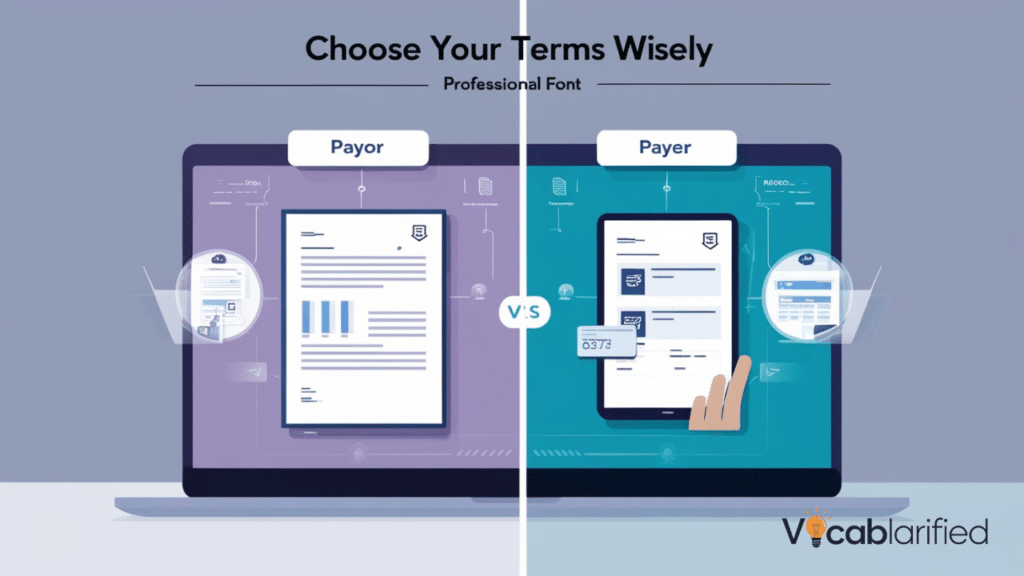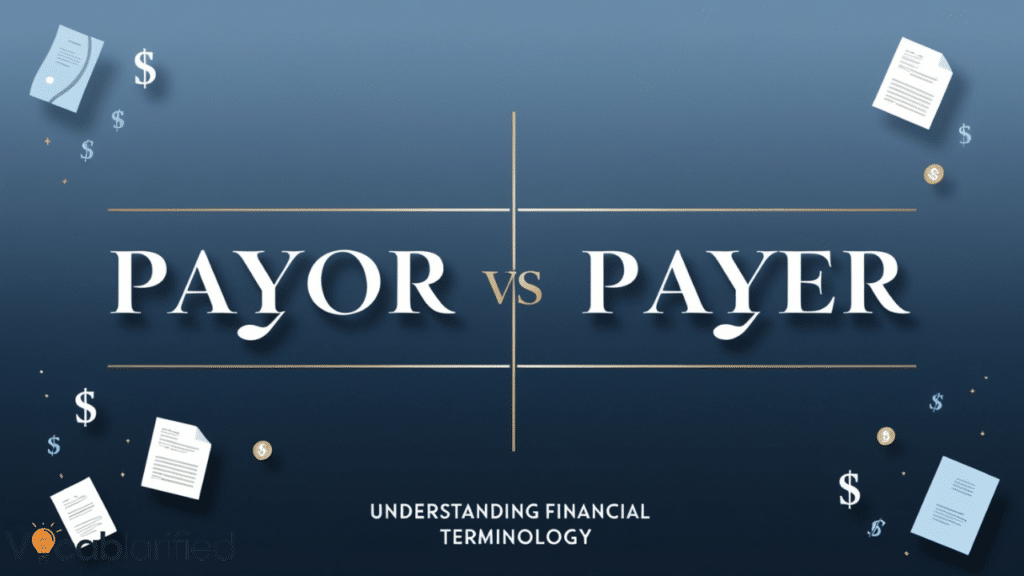The world of financial terminology can be complex and nuanced, particularly when it comes to seemingly interchangeable words like payor and payer.

While these terms might appear identical at first glance, they carry subtle yet significant distinctions that can impact clarity in communication across various professional and legal contexts.
Origins of Terminology
Language evolves continuously, and financial vocabulary is no exception. The terms payor and payer have emerged from different professional domains, each with its own specific usage and historical context. Understanding these subtle variations becomes crucial in business communications and legal documents.
Linguistic Breakdown
In professional writing, precision matters immensely. Payor and payer represent two spelling variations that have developed across different sectors. Traditionally, payor has been more prevalent in insurance policies and healthcare billing, while payer sees more widespread use in everyday transactions.
Professional Context Matters
Formal vs. Informal Context
The choice between payor and payer often depends on the contextual usage. Formal financial agreements typically lean towards payor, especially in contract language where every word carries legal weight.
| Professional Context | Preferred Term | Typical Usage |
|---|---|---|
| Medical Billing | Payor | Insurance claim processing |
| Banking | Payer | Transaction documentation |
| Legal Contracts | Payor | Formal agreement drafting |
| Personal Finance | Payer | Everyday financial interactions |
| Corporate Accounting | Payor | Official financial reporting |
| Payment Platforms | Payer | User-friendly interfaces |
| Government Documents | Payor | Official administrative paperwork |
| International Transactions | Payer | Global financial communications |
| Academic Research | Payor | Scholarly financial analysis |
| Small Business | Payer | Casual business interactions |
You Might Like: Re-sign or Resign? Learn When and How to Use Each Correctly
Legal and Financial Implications
In legal documents, the term chosen can subtly influence interpretation. Payor often implies a more structured, formal entity with specific payment obligations, while payer might suggest a more general financial actor.
Email Communication Example
Consider an email demonstrating the nuanced use of these terms:
Subject: Insurance Claim Payment Verification
Dear Ms. Emily Rodriguez,
I am writing regarding the recent insurance claim submitted by our payor, Blue Cross Blue Shield. As the designated payer for medical services, we require additional documentation to process the claim efficiently.
Sincerely,
Michael Thompson
Claims Department
Pronunciation and Spelling
Interestingly, despite their different spellings, both payor and payer are pronounced identically. This phonetic similarity contributes to their frequent interchangeability in common usage.
| Spelling Variation | Professional Preference | Industry Frequency |
|---|---|---|
| Payor | Medical, Legal | High in formal documents |
| Payer | General Finance | More common in casual contexts |
| Pay-er | Pronunciation | Identical for both spellings |
| Pay-or | Linguistic Origin | Reflects Latin-derived financial terminology |
You Might Like: Connotation vs Denotation | Definitions, Differences, and Examples
Precision in Language
Precise language becomes paramount in financial agreements. The selection between payor and payer reflects not just spelling preference but also professional sophistication and domain-specific communication standards.
Payer Examples in Context
A comprehensive look at payer examples reveals the term’s versatility across different financial scenarios:
| Scenario | Payer Role | Transaction Type |
|---|---|---|
| Utility Bill | Residential Customer | Monthly service payment |
| Subscription Service | Individual User | Recurring digital service |
| Freelance Work | Client | Project-based compensation |
| Mortgage Payment | Homeowner | Regular financial obligation |
| Online Purchase | Consumer | E-commerce transaction |
| Tuition Payment | Student/Parent | Educational expense |
| Tax Contribution | Citizen | Government revenue |
| Rental Agreement | Tenant | Monthly property rental |
| Insurance Premium | Policy Holder | Risk management payment |
| Loan Repayment | Borrower | Debt settlement |
Emerging Trends
The digital age continues to influence financial terminology. While traditional distinctions persist, modern communication platforms are gradually blurring these linguistic boundaries.
Healthcare Billing Insights
Healthcare billing represents a critical domain where the terms payor and payer hold significant weight. Medical institutions carefully navigate these financial terminology nuances to ensure precise communication and payment obligations.
Insurance Industry Perspective
In insurance policies, the term payor typically refers to the entity responsible for making payments. This could be an insurance company, government agency, or corporate health plan handling medical expense reimbursements.
| Insurance Type | Typical Payor | Payment Mechanism |
|---|---|---|
| Private Health Insurance | Blue Cross Blue Shield | Direct claim reimbursement |
| Government Healthcare | Medicare | Federal payment system |
| Employer-Sponsored Plans | Corporate HR Departments | Group insurance settlements |
| Workers’ Compensation | State Insurance Funds | Occupational injury coverage |
| Supplemental Insurance | Private Supplementary Providers | Additional medical expense support |
| Military Healthcare | Veterans Affairs | Service-related medical payments |
| State Medicaid | State Government Agencies | Low-income healthcare support |
| International Health Plans | Global Insurance Networks | Cross-border medical coverage |
| Specialized Care Insurance | Condition-Specific Providers | Targeted medical expense management |
| Research Hospital Networks | Academic Medical Centers | Comprehensive care financing |
You Might Like: Litre and Liter | Spelling Differences and When to Use Each
Professional Communication Strategies
Business communications demand clarity in communication. Professionals must understand the subtle distinctions between payor and payer to maintain precise language in various contexts.

Contextual Usage Scenarios
An email exchange between Sarah Williams, a financial coordinator, and David Thompson, an insurance claims manager, illustrates these nuanced terminology differences:
Subject: Payment Processing Clarification
Dear David,
I’m writing to confirm the payor details for our recent medical service claim. As the primary payer, could you verify the processing timeline?
Best regards,
Sarah Williams
Legal and Contractual Implications
Contract language requires meticulous attention to terminology. Precise language becomes critical in financial agreements where every word carries potential legal significance.
Payer Examples in Legal Documentation
| Legal Document Type | Preferred Term | Contextual Significance |
|---|---|---|
| Service Agreements | Payer | Defining payment responsibilities |
| Medical Billing Contracts | Payor | Specifying insurance claim processes |
| Construction Contracts | Payer | Outlining payment schedules |
| Loan Documentation | Payor | Identifying financial obligation source |
| Intellectual Property Agreements | Payer | Establishing licensing fee mechanisms |
| Rental Agreements | Payer | Defining tenant payment responsibilities |
| Employment Contracts | Payor | Specifying compensation structures |
| Franchise Agreements | Payer | Establishing royalty payment terms |
| Professional Service Contracts | Payor | Defining service compensation |
| International Trade Agreements | Payer | Managing cross-border financial transactions |
Linguistic Evolution
The ongoing digital transformation continues to influence financial terminology. While traditional distinctions persist, modern communication platforms gradually reshape linguistic boundaries.
Global Financial Perspectives
Terminology differences in financial communication extend beyond national boundaries. Different regions and economic systems interpret financial terminology with unique nuances that impact professional writing and business communications.
International Financial Landscape
The global marketplace demands precise language in financial agreements. Multinational corporations must navigate complex contextual usage of financial terms to ensure clarity in communication.
| Region | Preferred Term | Financial Context |
|---|---|---|
| United States | Interchangeable | Flexible usage |
| United Kingdom | Payer | Traditional financial writing |
| Australia | Payer | Standard business communication |
| Canada | Payor/Payer | Bilingual legal documentation |
| European Union | Payer | Standardized financial reporting |
| Singapore | Payer | International business practices |
| Middle East | Payor | Formal legal documentation |
| India | Payer | Growing financial markets |
| Japan | Payer | Precise financial terminology |
| Brazil | Pagador | Portuguese linguistic adaptation |
Technology and Financial Terminology
Digital platforms continue to reshape how we understand and utilize financial terminology. Everyday transactions now rely heavily on technological interfaces that challenge traditional linguistic boundaries.
Digital Payment Ecosystems
Payment obligations in the digital age require sophisticated understanding of payer and payor contexts. Online platforms often blend formal and informal communication styles.
| Digital Platform | Terminology Usage | Payment Mechanism |
|---|---|---|
| PayPal | Payer | Online transaction |
| Stripe | Payer | Payment processing |
| Venmo | Sender | Peer-to-peer transfers |
| Apple Pay | Payer | Mobile transactions |
| Cryptocurrency Exchanges | Sender/Payer | Blockchain transactions |
| Banking Apps | Payer | Digital financial services |
| International Transfer Platforms | Payor | Cross-border payments |
| Subscription Services | Payer | Recurring billing |
| Crowdfunding Platforms | Contributor | Project funding |
| Freelance Marketplaces | Client/Payer | Professional services |
Professional Writing Considerations
Contract language demands exceptional attention to precise language. Professionals must carefully select terminology that communicates exact payment obligations and financial responsibilities.
Email Communication Example
Subject: Financial Agreement Clarification
Dear Mr. Robert Chen,
As the designated payor for our upcoming project, we require clarification on the proposed payment structure. Our financial team will review the payer details to ensure comprehensive understanding.
Sincerely,
Amanda Rodriguez
Chief Financial Officer
Academic and Research Perspectives
Scholarly research increasingly examines the linguistic nuances of financial terminology. Precise language becomes a critical component of understanding complex economic interactions and financial agreements.
Legal and Regulatory Framework
Legal documents provide a critical lens for understanding the intricate nuances of financial terminology. Different jurisdictions interpret payor and payer with varying degrees of specificity and legal weight.
Regulatory Compliance
Professional writing in financial contexts demands meticulous attention to terminology. Regulatory bodies increasingly emphasize precise language in financial agreements to minimize potential misinterpretations.
| Regulatory Domain | Terminology Preference | Compliance Implications |
|---|---|---|
| Federal Banking Regulations | Payer | Standard financial reporting |
| Healthcare Compliance | Payor | Medical billing standards |
| Insurance Regulatory Bodies | Payor | Claim processing documentation |
| International Trade Regulations | Payer | Cross-border transaction records |
| Tax Authority Documentation | Payor | Official financial reporting |
| Corporate Governance | Payer | Shareholder communication |
| Consumer Protection Agencies | Payer | Financial transparency |
| Securities and Exchange Commission | Payer | Investment documentation |
| Professional Licensing Boards | Payor | Service provider agreements |
| Anti-Money Laundering Frameworks | Payer | Transaction verification |
Linguistic Nuances in Professional Contexts
Business communications require nuanced understanding of terminology differences. Professionals must navigate the subtle distinctions between payor and payer to maintain clarity in communication.
Professional Scenario Analysis
An internal memo demonstrates the delicate use of financial terminology:
Subject: Payment Processing Protocol
Attention Finance Team,
Our organization recognizes the critical distinction between payor entities and payer responsibilities. Moving forward, all financial agreements will reflect precise linguistic standards.
Regards,
Michael Thompson
Chief Financial Officer
Healthcare Industry Insights
Healthcare billing represents a unique domain where payor terminology carries significant weight. Medical institutions carefully distinguish between various payment entities and their specific roles.

| Healthcare Sector | Payor Classification | Payment Mechanism |
|---|---|---|
| Private Hospitals | Insurance Companies | Direct claim reimbursement |
| Public Healthcare | Government Agencies | Standardized payment systems |
| Specialty Clinics | Corporate Health Plans | Specialized treatment coverage |
| Research Institutions | Grant Providers | Research funding channels |
| Pharmaceutical Companies | Healthcare Networks | Treatment protocol funding |
| Mental Health Services | Insurance Providers | Specialized care reimbursement |
| Emergency Medical Services | State Funding | Critical care support |
| Rehabilitation Centers | Multiple Payor Sources | Comprehensive treatment financing |
| Telemedicine Platforms | Digital Insurance Networks | Remote healthcare payments |
| Preventive Care Facilities | Wellness Program Sponsors | Proactive health management |
Technological Impact on Terminology
The digital revolution continues to transform how we understand and utilize financial terminology. Everyday transactions increasingly blur traditional linguistic boundaries, challenging established communication norms.

Communication Strategies
Clarity in communication remains paramount when navigating the complex landscape of financial terminology. Professionals must develop sophisticated strategies to manage terminology differences effectively.
Practical Application
Understanding the nuanced use of payor and payer requires more than linguistic knowledge. It demands a comprehensive approach to professional writing and precise language.
| Communication Strategy | Key Considerations | Implementation Approach |
|---|---|---|
| Contextual Adaptation | Understand Industry Norms | Flexible Terminology Use |
| Consistent Documentation | Maintain Uniform Style | Organizational Guidelines |
| Cross-Departmental Communication | Align Terminology | Internal Training Programs |
| Client-Facing Communication | Clarity and Precision | Simplified Language Approach |
| Legal Compliance | Regulatory Adherence | Structured Linguistic Frameworks |
| Global Business Interactions | Cultural Sensitivity | Adaptive Communication Techniques |
| Technology Integration | Digital Communication Platforms | Standardized Terminology Protocols |
| Professional Development | Continuous Learning | Language Skill Enhancement |
| Risk Management | Minimize Misinterpretation | Comprehensive Communication Strategies |
| Interdisciplinary Collaboration | Comprehensive Understanding | Cross-Functional Language Approaches |
Final Considerations
Financial agreements demand exceptional attention to linguistic details. The choice between payor and payer extends beyond mere spelling – it represents a sophisticated understanding of professional communication.
Professional Email Example
Subject: Terminology Clarification Request
Dear Jennifer Martinez,
Our team seeks to standardize our financial terminology across all business communications. We’re conducting a comprehensive review of payer and payor usage in our contract language.
Regards,
Thomas Henderson
Communications Director
Emerging Trends
The digital transformation continues to challenge traditional linguistic boundaries. Everyday transactions now require more flexible approaches to financial communication.
Future Outlook
Professionals must remain adaptable, recognizing that financial terminology will continue evolving with technological advancements and global economic shifts.
Conclusion
The distinction between payor and payer represents more than a simple spelling variation. It embodies the complex landscape of precise language in financial communications, reflecting the nuanced world of professional interactions and financial agreements.

Emma Carter is an experienced blogger at Vocablarified. She enjoys helping people expand their vocabulary and improve their language skills. With a warm and approachable writing style, Emma makes learning new words fun and accessible. When she’s not writing, she loves reading books and discovering new phrases to share with her readers. Emma is passionate about making language learning an enjoyable journey for everyone.







